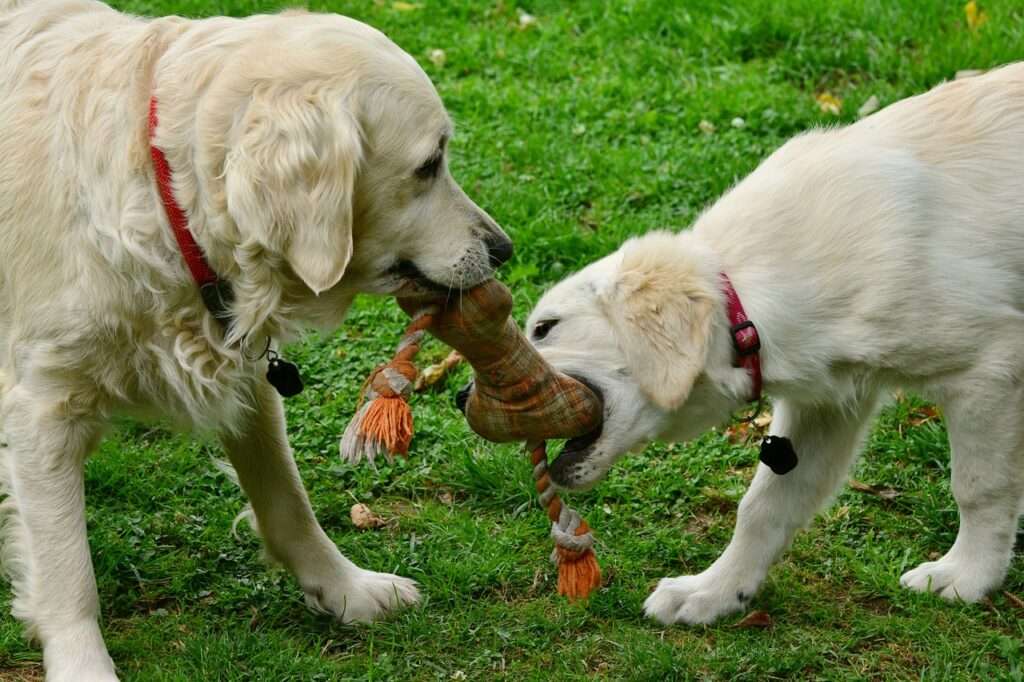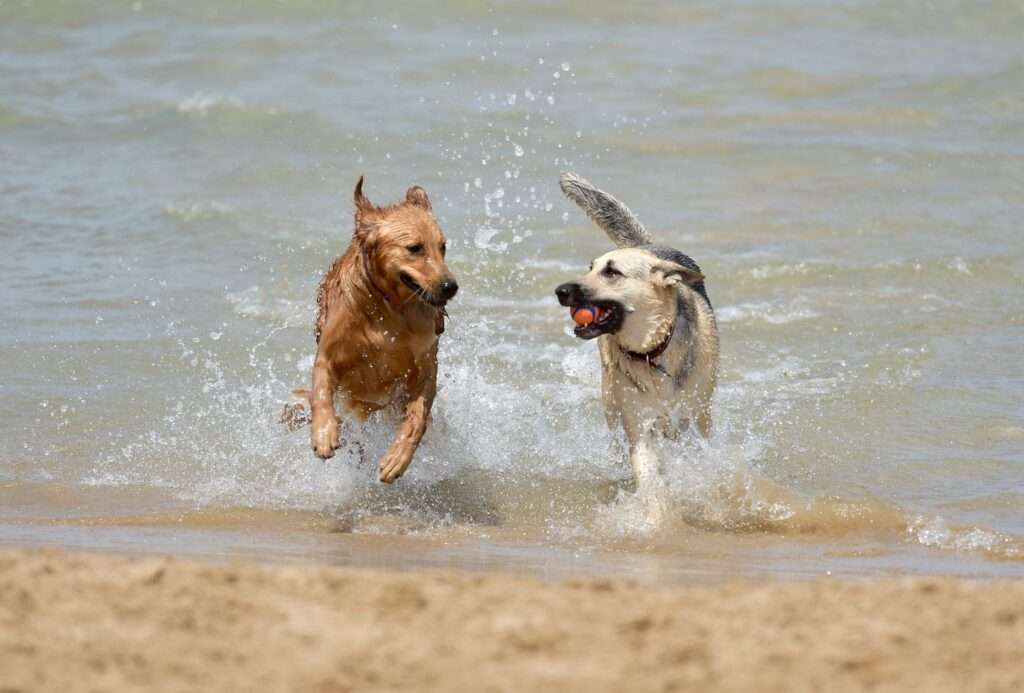16 Foolproof Techniques for Introducing a New Dog to a Jealous Dog
Bringing a new furry friend into your home is an exciting adventure, but when you already have a dog that’s showing signs of jealousy, it’s essential to navigate this introduction with care and compassion. Here at BarkLikeMeow, we understand the significance of introducing a new dog to a potentially jealous companion, and that’s why we’ve crafted this comprehensive guide to help you sail through this process smoothly.
We know how crucial it is to create a harmonious environment for your pets, and that’s exactly what we aim to achieve in this guide. By addressing every angle related to introducing a new dog to a jealous dog, you’ll be equipped with the knowledge and tools to ensure a happy and peaceful coexistence in your fur family.
Assessing Your Current Dog’s Behavior and Personality

The first step in introducing a new dog to a jealous dog is understanding your current pup’s behavior and personality. Each dog is unique, and recognizing the signs of jealousy is vital in determining the right approach for a successful introduction.
Keep an eye out for subtle cues that indicate jealousy, such as excessive barking, growling, or possessiveness over toys or food. Identifying dominant or submissive traits will also play a significant role in their initial interactions with the newcomer.
Taking a trip down memory lane and evaluating your dog’s socialization history can provide valuable insights into how they might react to a new furry sibling. If they’ve had positive experiences with other dogs in the past, it might indicate a higher likelihood of a smooth introduction.
However, if you encounter any uncertainties or your dog displays concerning behaviors, don’t hesitate to seek advice from a professional behaviorist. Their expertise can prove invaluable in understanding and addressing any underlying issues, ensuring a well-rounded and successful introduction process.
Stay tuned for the upcoming parts of this guide, where we’ll delve into the preparation steps and gradual introduction techniques to create a warm and loving bond between your dogs. Remember, every dog deserves a chance to embrace new friendships, and with the right approach, your fur family will thrive harmoniously!
Preparing for the Introduction
Proper preparation is the cornerstone of a successful introduction between dogs. Setting realistic expectations and creating a safe, neutral environment for the initial meeting is key to fostering a positive relationship from the start.
Begin by acknowledging that introducing a new dog to a jealous dog may take time and patience. Remember, each pup has its unique personality, and the adjustment period might vary. Stay optimistic and approach the introduction with a positive mindset.
Before the big day arrives, take the time to learn about the background and personality of the new dog you’ll be bringing home. Understanding their history can help you anticipate how they might interact with your current furry family member.
Creating a safe and neutral environment means removing any items that may trigger possessive behaviors, such as favorite toys or food bowls. This ensures that both dogs are on an equal footing during their first encounter.
Additionally, don’t forget to check that both dogs are up-to-date with their vaccinations and in good health. Keeping them healthy will minimize any potential stress during the introduction process.
Gradual Introduction Techniques
At our core, we understand that slow and steady wins the race when it comes to introducing dogs to one another. By employing gradual introduction techniques, you can facilitate a positive and stress-free initial meeting.
- Scent Exchange: Dogs rely heavily on their sense of smell to understand the world around them. Prior to the introduction, swap bedding or toys between the two dogs, allowing them to get familiar with each other’s scent. This simple step can help ease their anxiety and create a sense of familiarity.
- Controlled Visual Contact: Using baby gates or crates, allow the dogs to see each other without direct physical interaction. This approach provides a safe way for them to observe and acclimate to the presence of a new companion.
- Leashed Introduction in Neutral Territory: Once both dogs seem comfortable with each other’s scent and presence, arrange a leashed introduction in a neutral location, like a park or a quiet street. Keep the leashes loose to allow them to approach at their pace, promoting a relaxed and friendly atmosphere.
- Group Walks and Outdoor Bonding Activities: As the dogs become more comfortable with each other, engage in group walks and outdoor activities to further strengthen their bond. Exploring the great outdoors together can create positive associations and encourage camaraderie.
Positive Reinforcement and Training
We firmly believe that positive reinforcement and training are the cornerstones of building a strong and harmonious relationship between dogs. During the introduction process, these techniques can help instill positive associations and create a sense of camaraderie between your furry companions.
- Using Treats and Rewards: Treats and rewards are powerful tools in encouraging desired behaviors. Whenever the dogs exhibit friendly and relaxed interactions, reward them with their favorite treats, affection, or praise. This positive reinforcement reinforces their good behavior and strengthens their bond.
- Implementing Clicker Training: Clicker training is an effective method to associate the sound of a clicker with positive actions. Use the clicker when your dogs display friendly behavior towards each other, and follow it up with treats or rewards. Over time, they’ll understand that this sound leads to something enjoyable.
- Addressing Jealousy and Resource Guarding: If you notice signs of jealousy or resource guarding during the introduction, address them promptly with training techniques. Gradually teach your dogs to share toys and resources, rewarding them when they do so willingly. This will promote a positive environment and discourage negative behaviors.
- Consistency and Patience: Remember, positive reinforcement and training take time. Be patient and consistent in your approach, and avoid punishing negative behaviors. Instead, focus on rewarding the behaviors you want to encourage. With time and dedication, your furry friends will learn to trust and respect each other.
Monitoring and Recognizing Stress Signals

As devoted pet parents, it’s essential to keep a watchful eye on our dogs and be attuned to their body language. Recognizing stress signals during the introduction process can help prevent potential conflicts and ensure a smooth transition.
- Understanding Canine Body Language: Dogs communicate primarily through body language. Learn to recognize stress signals such as lip licking, yawning, tense body postures, and avoidance behaviors. When you notice these signs, it’s essential to give the dogs space and reduce the intensity of the introduction.
- Identifying Signs of Aggression and Fear: While most introductions proceed smoothly, there might be instances where dogs display aggression or fear. Raised hackles, growling, and snapping are signs of potential conflict. In such cases, separate the dogs immediately and consult with a professional behaviorist to address the issue safely.
- Intervening to Prevent Escalation: If you observe escalating tension between the dogs, it’s crucial to intervene calmly and confidently. Use distraction techniques like calling them for treats or redirecting their focus to toys. By doing so, you can prevent the situation from escalating into a negative encounter.
- Allowing for Breaks and Individual Space: During the introduction, ensure both dogs have opportunities for breaks and individual space. This time apart can help reduce tension and prevent overwhelming emotions. As they become more comfortable with each other, gradually increase the time they spend together.
Integrating the Dogs in the Household
A successful introduction is just the beginning of a long-lasting friendship between your furry companions. Integrating the dogs into your household requires careful management and thoughtful consideration to ensure everyone feels comfortable and secure.
- Supervised Playtime and Interaction: As the dogs grow more comfortable with each other, gradually increase their supervised playtime. Observe their interactions closely to ensure they remain positive and friendly. If any signs of tension arise, redirect their focus or separate them for a short break.
- Feeding Time Strategies: Mealtime can be a sensitive period for some dogs, especially during the integration process. Consider feeding them in separate areas to avoid resource guarding. If they have no issues sharing, you can also try feeding them side by side to encourage camaraderie.
- Sharing Toys and Resources: Encourage positive sharing behaviors by offering a variety of toys and resources that both dogs enjoy. When they share willingly, reward them with praise or treats. Avoid situations where they may feel the need to compete for limited resources.
- Providing Separate Resting Areas: Just like humans, dogs need their personal space and downtime. Ensure each pup has a comfortable and separate resting area where they can retreat to when they need a break or some alone time.
Strengthening the Bond between Dogs

Nurturing strong bonds between dogs is paramount, and there are numerous ways to reinforce the friendship between your furry pals.
- Facilitating Positive Shared Experiences: Plan activities that both dogs can enjoy together, such as fun outings to the park or beach. These shared experiences can create lasting memories and strengthen their bond.
- Joint Training Sessions and Games: Engaging in training sessions and interactive games together can be both fun and rewarding for the dogs. Participate in group training exercises, teach them new tricks, or enjoy a game of fetch with both dogs simultaneously.
- Group Outings and Adventures: Regularly expose the dogs to new environments and experiences as a team. This not only promotes bonding but also helps build their confidence and social skills.
- Encouraging Play and Socialization: Play is a natural way for dogs to bond and communicate. Allow them ample time for play and socialization, both with each other and with other friendly dogs.
Addressing Common Challenges
Introducing a new dog to a jealous dog can sometimes present its fair share of challenges. However, with the right strategies and approach, these hurdles can be overcome, paving the way for a harmonious fur family.
- Handling Food Aggression and Territorial Behavior: Food aggression and territorial behavior can be significant concerns during the introduction process. To address this, feed the dogs separately and gradually work on desensitizing them to each other’s presence during mealtime. Seek guidance from a professional behaviorist if these issues persist.
- Coping with Attention-Seeking and Attention-Deficit Issues: Each dog has its unique personality, and some may require more attention than others. Ensure you give each dog individual attention and affection to prevent feelings of jealousy or neglect. Engaging in one-on-one activities with each pup can strengthen their bond with you.
- Resolving Sibling Rivalry and Competition: Sibling rivalry can occur in multi-dog households. Manage this by providing equal attention, treats, and affection to all dogs to avoid any feelings of competition. Celebrate their unique qualities and ensure they each have their special moments with you.
- Tackling Separation Anxiety in the Jealous Dog: The introduction of a new dog may trigger separation anxiety in the resident pup. Gradually acclimate them to short periods of separation and provide engaging toys or treats to keep them occupied when alone.
Time and Patience: A Key to Success
The significance of time and patience during the introduction process cannot be emphasized enough. Every dog adjusts at its own pace, and building a strong bond takes dedication and understanding.
- Understanding that Adjustments Take Time: Just like forming friendships among humans, dogs need time to develop trust and familiarity with each other. Avoid rushing the process and allow them to set the pace for their relationship.
- Celebrating Small Wins and Progress: Recognize and celebrate even the smallest positive interactions between your dogs. Whether it’s sharing a toy or playing together, these little victories signify progress and contribute to their growing bond.
- Staying Patient and Resilient: Expect bumps in the road during the integration period, and remember that setbacks are normal. Stay patient and resilient, and continue using positive reinforcement techniques to encourage the behavior you want to see.
- Seeking Professional Help for Persistent Issues: If you encounter persistent challenges during the introduction or notice signs of escalating aggression, don’t hesitate to seek professional help. A skilled behaviorist can provide expert guidance tailored to your dogs’ unique needs.
Conclusion
Congratulations on taking the exciting step of introducing a new dog to your jealous companion! At BarkLikeMeow, we’ve provided you with a comprehensive guide to ensure a smooth and successful integration process. Understanding your current dog’s behavior and personality is vital for a positive introduction.
Gradual techniques, positive reinforcement, and training will pave the way for a strong bond between your furry pals. Monitoring stress signals is crucial to prevent conflicts and create a safe environment for both dogs. Address common challenges with patience and care, embracing every small triumph and staying resilient through setbacks.
With time and dedication, your fur family will flourish, creating cherished memories for years to come. We’re here to support you every step of the way, offering expert advice and a commitment to your pets’ well-being.
Thank you for trusting us as your go-to resource for all things pet-related. Your fur family’s happiness is our priority, and we’re excited to be part of this journey with you. Wishing you a lifetime of love, joy, and paw-some adventures ahead!
Frequently Asked Questions
Q: How can I ensure a successful introduction between my new and established dogs?
A: Techniques such as taking the dogs to the garden, calmly and gently approaching with the new dog, and closely monitoring your dog’s body language can help facilitate a positive interaction and bonding between the dogs.
Q: Can I introduce the dogs directly in my home?
A: It’s generally recommended to start with neutral territory, such as a park or a quiet street, for the initial introduction. This helps prevent territorial behaviors and allows the dogs to focus on getting acquainted without any preexisting associations.
Q: What if the dogs don’t get along during the introduction?
A: If tensions arise during the introduction, it’s crucial to separate the dogs and consult with a professional behaviorist. They can provide guidance tailored to your specific situation and help address any underlying issues.
Q: How long does it typically take for dogs to adjust and accept each other?
A: The adjustment period varies for each dog and can range from a few days to several weeks. Patience is key, as it takes time for them to establish trust and a positive relationship.
Q: How to introduce a new puppy to a jealous dog?
A: When introducing a new puppy to a jealous dog, it’s important to gradually acclimate them to short interactions under supervision, allowing the dogs to get used to each other’s scents and gradually increasing their time together. It’s essential to provide positive reinforcement, equal attention, and patience during the introduction process to help both dogs build a positive relationship.
Q: How can I help my established dog adjust and not feel jealous of the new dog?
A: It’s important to ensure that both dogs receive equal attention and care. Additionally, swapping bedding or toys between the two dogs can help them get familiar with each other’s scent before the introduction.
Q: Is it possible to overcome resource guarding and food aggression?
A: Yes, resource guarding and food aggression can be addressed through positive reinforcement training. Gradual desensitization and reward-based techniques can help modify these behaviors and promote a harmonious environment.
Q: Should I leave the dogs unsupervised once they seem to get along?
A: Initially, it’s important to supervise the dogs during interactions to ensure their safety. As they continue to build trust and display positive behaviors consistently, you can gradually increase unsupervised time, always prioritizing the well-being of both dogs.
Q: How long should I keep my new dog separate from my jealous dog?
A: It’s important to keep them separate for as long as it takes to create a calm introduction. This can be as short as 24 hours, but don’t be afraid to wait several days or weeks if needed.
Q: Should I feed my dogs separately during the introduction period?
A: Yes, it’s recommended to feed the dogs separately and give treats and food to the established dog first to help maintain their sense of hierarchy and security.
Q: What signs should I look for to determine if my dog is experiencing jealousy?
A: Signs of jealousy can include excessive barking, growling, possessiveness over toys or food, and attention-seeking behavior when the new dog is present. It’s important to recognize these signs and address them with positive reinforcement and training.
Remember, every dog is unique, and these answers provide general guidance. If you have specific concerns or encounter challenges during the introduction process, consulting with a professional behaviorist is highly recommended.
References
- Berns, G. S. (2020). Do Dogs Feel Jealousy or Guilt? Psychology Today. Retrieved from: https://www.psychologytoday.com/sg/blog/smarter-you-think/202009/do-dogs-feel-jealousy-or-guilt
- American Kennel Club. (2021). How to Introduce Dogs. Retrieved from: https://www.akc.org/expert-advice/training/how-to-introduce-dogs/
- Veterinary Centers of America. (n.d.). Getting a Second Dog. Retrieved from: https://vcahospitals.com/know-your-pet/getting-a-second-dog
- The Humane Society of the United States. (n.d.). Introducing New Dogs. Retrieved from: https://www.humanesociety.org/resources/introducing-new-dogs
- Small Door Veterinary. (n.d.). Top 10 Dog Training Tips. Retrieved from: https://www.smalldoorvet.com/learning-center/behavior/top-10-dog-training-tips




